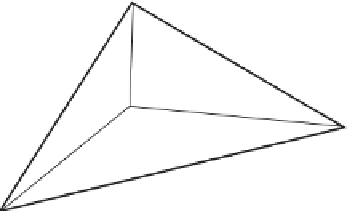Biomedical Engineering Reference
In-Depth Information
Fig. 6.17
A triangular cell
having an angle of
between
the surfaces normal to the
triangular parts of the faces
connected to two adjacent
triangles
6.4.2
Mesh Design Strategy
A meshing strategy is to create an initial coarse mesh topology (i.e. use a small
number of elements). This allows a quick solution which can be evaluated and the
model then later refined. A suitable coarse mesh allows a number of “test-runs” to
be carried out in quick turnaround time to assess the convergence or divergence
behaviour of the numerical calculations, and physical models. When the numerical
setup is correct and the solution is converging, mesh refinement is then undertaken
to achieve a more accurate solution. If the solution is diverging, then the mesh or
model setup needs to be debugged and investigated. Some possible sources of errors
can be attributed to
physical modeling
and
human
errors, and not necessarily the
numerical setup itself. During the testing phase, using a fine mesh could take hours
or days to simulate only find the solution is diverging or that the physical model
was applied incorrectly.
Since, there is no restriction on the use of particular cell type in an unstructured
grid arrangement, a
hybrid
mesh that combines different element types has the abil-
ity to match appropriate cells with boundary surfaces and allocating cells of various
element types in parts of the complex flow regions. For circular geometries such as
arteries, grid quality is enhanced through the placement of quadrilateral or hexahe-
dral elements in resolving the viscous boundary layers near the walls whilst triangu-
lar or tetrahedral elements are generated for the rest of the flow domain.
Finally, special grid design features such as O-grid or C-grid introduced earlier
need careful consideration of block interfaces as this significantly improves the
overall quality of a block-structured mesh. For example the presence of arbitrary
mesh coupling, non-matching cell faces, or extended changes of element types at
block interfaces should always be avoided in critical regions of high flow gradients
or high shear. Wherever possible, finer and more regular mesh in these critical re-
gions should be employed. In all cases, after preliminary testing the mesh should
be re-checked in critical regions of high flow gradients and large changes to ensure
the results are agreeing with validation data such as experiments or known flow
behaviour.















Search WWH ::

Custom Search